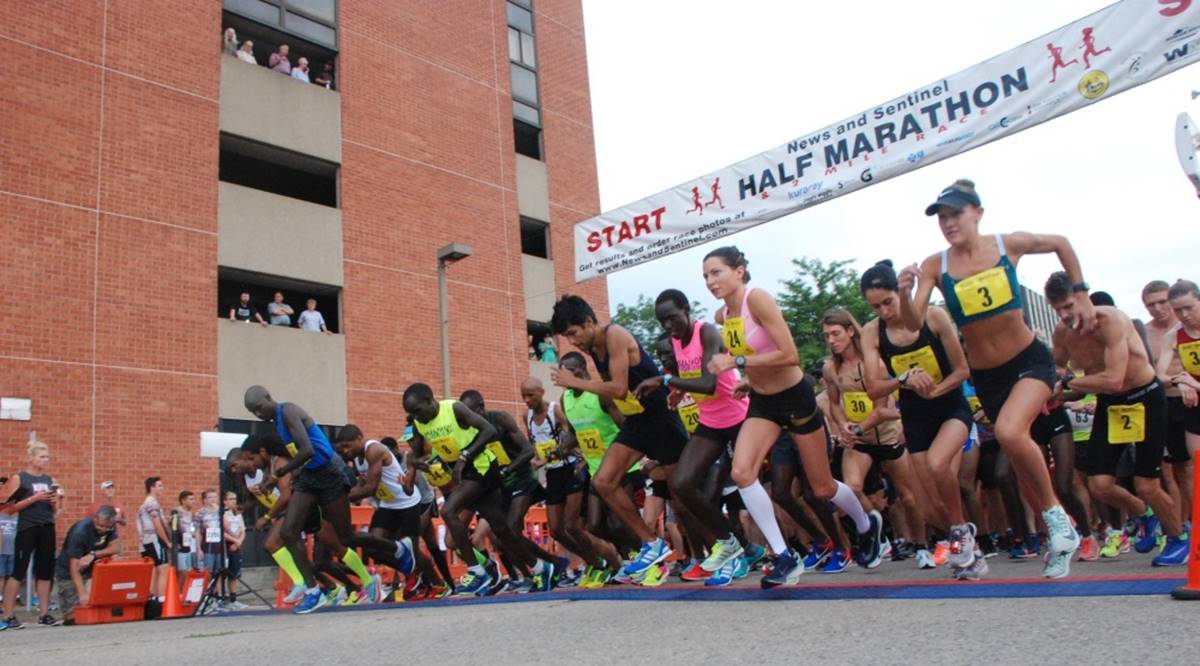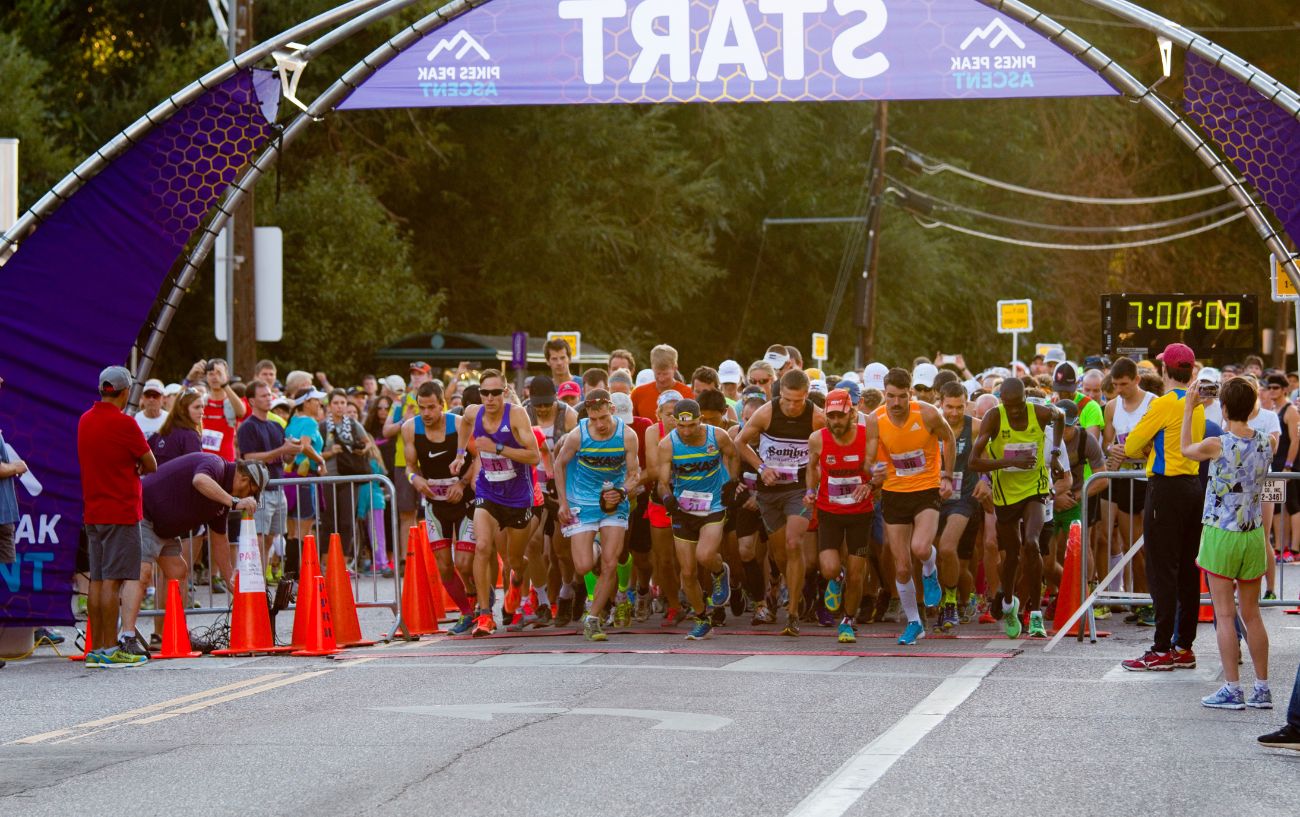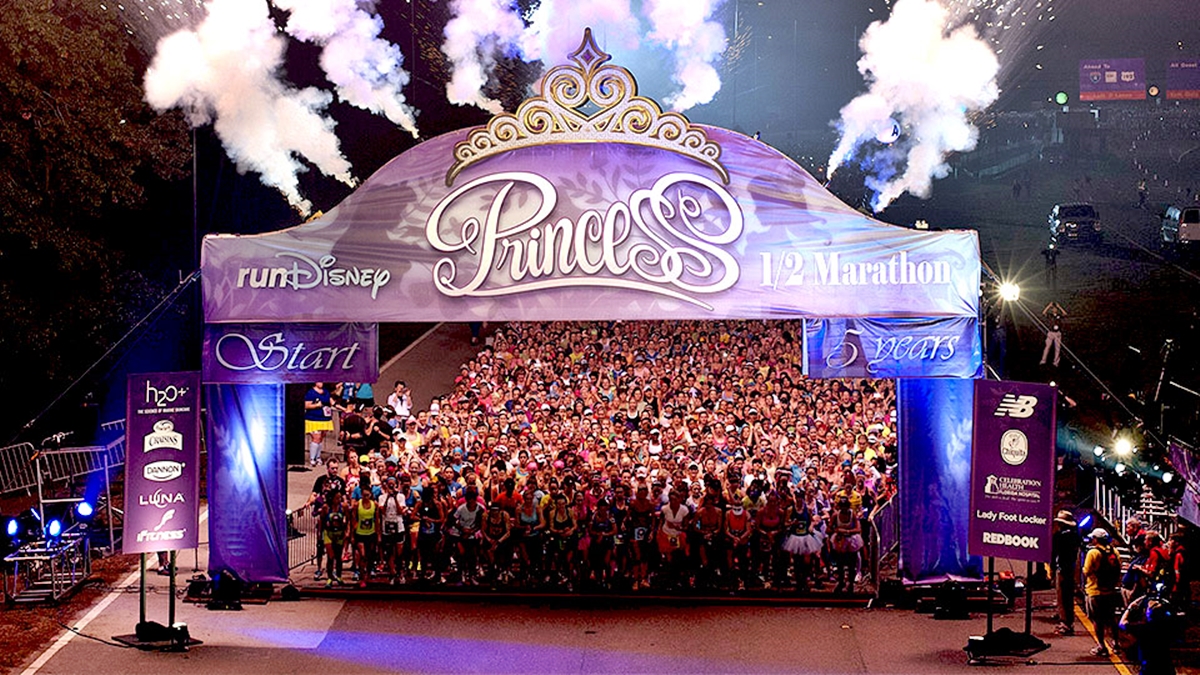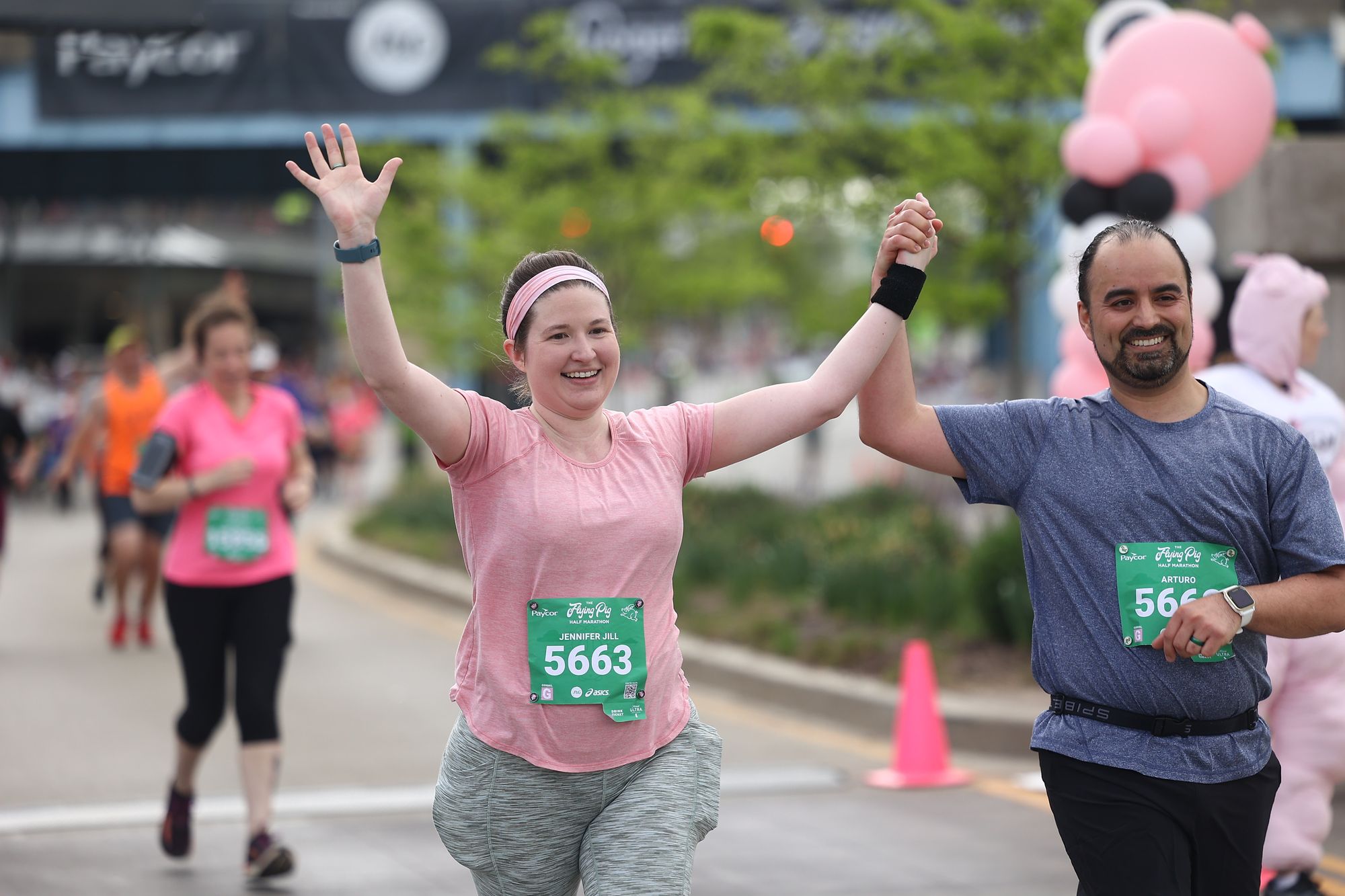

Featured
What Age Can You Run A Half Marathon
Modified: January 22, 2024
Discover the optimal age to run a half marathon and reach your running goals. Get featured insights on the recommended age for running your first half marathon.
Introduction
Running a half marathon can be an exciting and rewarding challenge for individuals of all ages. It offers a unique opportunity to push your physical limits, boost your mental well-being, and accomplish a significant fitness milestone. Whether you are a seasoned runner or just starting your fitness journey, completing a half marathon can be a fulfilling experience.
In this article, we will explore the recommended age to run a half marathon and discuss the various factors you should consider before embarking on this endeavor. We will also provide helpful tips on preparing for a half marathon, including training plans, injury prevention strategies, and nutrition guidelines. So, lace up your running shoes and let’s dive in!
Running a half marathon is a popular choice for both veteran runners and beginners seeking a new challenge. It provides a balance between the achievable distance of a 10k race and the endurance required for a full marathon. Half marathons typically cover a distance of 13.1 miles (21.1 kilometers), testing both your physical endurance and mental strength.
Regular running offers numerous health benefits, and participating in a half marathon amplifies these advantages. It can positively impact your cardiovascular fitness, strengthen your muscles and bones, help in weight management, and improve your overall well-being. Running can also boost your mood, reduce stress levels, and enhance cognitive function by increasing the production of endorphins—our body’s natural feel-good chemicals.
However, it is crucial to approach a half marathon with adequate preparation and consideration, particularly when it comes to age and fitness level. Running long distances requires a certain level of cardiovascular fitness, joint and muscle strength, and endurance. Therefore, it is important to understand the recommended age guidelines before taking on the challenge of a half marathon.
Benefits of Running a Half Marathon
Running a half marathon offers a plethora of benefits, both physical and mental. Let’s explore these advantages in detail:
Physical Benefits
1. Improved cardiovascular fitness: Training for and completing a half marathon requires consistent running, which strengthens your heart and lungs. This improved cardiovascular fitness lowers the risk of heart diseases, lowers blood pressure, and enhances overall endurance.
2. Weight management: Running is an effective way to burn calories and maintain a healthy weight. The long-distance nature of a half marathon helps in increasing calorie expenditure, aiding in weight loss or weight maintenance.
3. Stronger muscles and bones: The repetitive impact of running helps in building stronger leg muscles, including quadriceps, hamstrings, and calf muscles. It also improves bone density, reducing the risk of osteoporosis.
4. Increased stamina and endurance: Training for a half marathon gradually increases your stamina and endurance, allowing you to run longer distances without feeling fatigued. This enhanced endurance can translate to improved performance in other physical activities as well.
5. Boosted immune system: Regular exercise, including long-distance running, strengthens the immune system, reducing the risk of illnesses and infections.
Mental Benefits
1. Reduced stress and anxiety: Running releases endorphins, which are natural mood boosters. Engaging in a half marathon can alleviate stress, reduce symptoms of anxiety, and improve overall mental well-being.
2. Increased self-confidence: Completing a half marathon is a significant achievement that boosts self-esteem and self-confidence. The sense of accomplishment can extend to other areas of life, fostering a positive mindset.
3. Enhanced mental resilience: Training for a half marathon requires discipline, commitment, and perseverance. Overcoming various challenges during the training process can help develop mental resilience and mental toughness.
Running a half marathon is not just about crossing the finish line—it’s about the journey and the incredible benefits that come along with it. By pushing yourself to achieve this fitness milestone, you can experience a transformed body and mind.
Physical Benefits
When it comes to running a half marathon, the physical benefits are numerous and significant. Let’s delve into the ways in which participating in a half marathon can improve your physical health:
Improved cardiovascular fitness: Training for and completing a half marathon requires consistent running, which strengthens your heart and lungs. The sustained aerobic effort helps to increase your cardiovascular fitness, enhancing your heart’s ability to pump blood effectively and improving your lung capacity. As a result, you’ll experience improved heart health, reduced risk of cardiovascular diseases, and increased overall endurance.
Weight management: Running is an excellent form of exercise for those aiming to manage or lose weight. The long-distance nature of a half marathon allows you to burn a significant number of calories. Regular training and participation in the race can help you achieve or maintain a healthy weight and body composition.
Increased muscle strength and tone: Running a half marathon engages various muscle groups in your lower body. The repetitive impact of long-distance running helps to strengthen and tone muscles, including the quadriceps, hamstrings, calves, and glutes. As these muscles become stronger, you’ll experience improved lower body strength, stability, and balance.
Enhanced bone health: The impact and weight-bearing nature of running can contribute to improved bone mineral density, making your bones stronger and more resilient. Regular participation in a half marathon can help reduce the risk of osteoporosis and other bone-related conditions, particularly in older adults.
Increased stamina and endurance: One of the main physical benefits of training for and completing a half marathon is the significant improvement in stamina and endurance. As you gradually increase your training distance and intensity, your body becomes more efficient at utilizing oxygen and fuel. This leads to improved stamina and the ability to sustain physical exertion for longer periods without experiencing fatigue.
Boosted immune system: Engaging in regular exercise, including long-distance running, has been shown to enhance the functioning of the immune system. This can strengthen your body’s defense against various illnesses and infections, leading to better overall health and well-being.
By running a half marathon, you’re not only challenging yourself but also reaping substantial physical benefits. The combination of improved cardiovascular fitness, weight management, enhanced muscle strength, and increased stamina can have a transformative effect on your overall health and fitness levels.
Mental Benefits
Participating in a half marathon doesn’t just provide physical benefits—it also has a profound impact on your mental well-being. Here are some of the mental benefits you can expect from running a half marathon:
Reduced stress and anxiety: Running releases endorphins, which are neurotransmitters that act as natural painkillers and mood enhancers. Engaging in a half marathon, with its challenging yet rewarding nature, can help alleviate stress and anxiety. The rhythmic motion and increased oxygen flow during running promote relaxation, leaving you with a sense of calm and clarity.
Increased self-esteem and self-confidence: Crossing the finish line of a half marathon is an incredible accomplishment. The sense of achievement and the recognition of your determination and hard work can significantly boost your self-esteem and self-confidence. The experience of overcoming challenges during training and the race itself can translate into increased belief in your abilities and a more positive self-perception.
Improved mental resilience: Training for and completing a half marathon requires discipline, commitment, and perseverance. Throughout the training process, you will encounter various obstacles and setbacks. By pushing through these challenges and continuing to work towards your goal, you develop mental resilience and the ability to overcome adversity. This mental toughness can positively impact other areas of your life, both on and off the running track.
Enhanced mood and mental well-being: Running has been shown to boost mood and alleviate symptoms of depression. Engaging in a half marathon can help regulate your brain chemistry, leading to an increased production of endorphins and other feel-good neurotransmitters. The sense of accomplishment, improved fitness, and the social aspect of participating in a race can all contribute to improved mental well-being and increased happiness.
Stress relief: Running allows for a temporary escape from the pressures and stressors of everyday life. The solitude and freedom of the road or trail provide a space for reflection, processing emotions, and finding mental clarity. It allows you to shift your focus away from worries and concerns, promoting a sense of calm and balance.
Running a half marathon is not only a physical test but also a mental one. The mental benefits of participating in a race can have a profound and lasting impact on your overall well-being. From reduced stress and increased self-confidence to improved mental resilience and mood enhancement, the mental rewards of running a half marathon are significant.
Factors to Consider Before Running a Half Marathon
Before embarking on the journey of running a half marathon, there are several factors that you should carefully consider. These factors play a crucial role in ensuring your readiness and minimizing the risk of potential injuries or setbacks. Here are the key factors to keep in mind:
Age: Age is an important factor to consider when deciding to run a half marathon. While there is no specific age restriction, it is essential to assess your physical capabilities and consult with a healthcare professional if you have any concerns. Younger individuals may have different training needs and considerations compared to older adults.
Fitness Level: Your current fitness level is another crucial factor to consider. Running a half marathon requires a certain level of cardiovascular fitness, joint and muscle strength, and endurance. Assess your fitness level honestly and determine if you need to build a foundation of fitness before taking on the half marathon challenge.
Training Experience: Prior running experience or training for shorter distances, such as 5k or 10k races, can be beneficial before attempting a half marathon. It helps you understand your body’s response to running, build endurance gradually, and develop proper running form and technique.
Injury History: Consider any previous injuries or underlying health conditions that may impact your ability to run a half marathon. It’s important to give your body enough time to recover from any past injuries and address those conditions before starting a rigorous training program.
Time Commitment: Training for a half marathon requires a significant time commitment. Consider your schedule and ensure that you have enough time to dedicate to consistent training sessions. It’s crucial to allocate time for both running and cross-training activities to improve overall fitness and prevent overuse injuries.
Support System: Having a supportive network can greatly contribute to your success in running a half marathon. Surround yourself with individuals who motivate and encourage you throughout your training journey. Joining a local running club or finding a running buddy can provide additional guidance, accountability, and a sense of community.
Personal Goals: Reflect on your personal goals and motivations for running a half marathon. Are you aiming for a specific time goal, running for charity, or simply challenging yourself? Understanding your objectives will help you structure your training plan and stay motivated throughout the process.
Considering these factors before committing to a half marathon can help set you up for a successful and enjoyable experience. Take the time to assess your readiness, consult with professionals if needed, and create a plan that aligns with your abilities and goals. Remember, running a half marathon is a significant achievement, and being prepared both mentally and physically is key to crossing that finish line with pride.
Age
Age is an important factor to consider when determining your readiness to run a half marathon. While there is no specific age restriction for participating in a half marathon, it is essential to assess your physical capabilities and understand the potential impact of age on your training and performance. Here are some age-related considerations:
Children and Adolescents: It is generally recommended that children and adolescents wait until their bodies have fully matured before attempting a half marathon. The intense and prolonged training required for long-distance running can place excessive stress on growing bones, joints, and muscles, potentially leading to injuries. Younger individuals may be better suited for shorter distance races that align with their developmental stage.
Young Adults: Young adults in their late teens to early twenties are often in their prime physical condition, with excellent cardiovascular fitness and energy levels. This age group may find it easier to adapt to the demands of half marathon training, provided they have a solid fitness foundation and gradually increase their mileage in a controlled manner.
Middle-aged Adults: Middle-aged adults, typically between the ages of 40 to 60, can still pursue the goal of running a half marathon. However, it is important to take into account factors such as overall health, fitness level, and any existing medical conditions. Consulting with a healthcare professional before starting a training program is advisable to ensure that you approach the half marathon safely and without compromising your well-being.
Older Adults: Older adults, typically 60 years and above, can also successfully participate in a half marathon with proper preparation and caution. It is crucial for older individuals to focus on injury prevention, flexibility exercises, and cross-training activities to maintain joint mobility, muscle strength, and balance. Regular check-ups with a healthcare professional to monitor any age-related health conditions are recommended.
While age can influence your approach to running a half marathon, it is essential to remember that age is just one factor among many. It is important to assess your overall health, fitness level, and consider any underlying medical conditions or physical limitations you might have. Everyone is unique, and it’s critical to listen to your body and adapt your training plan accordingly.
Regardless of your age, it is advisable to start your half marathon training gradually and build up your endurance over time. Creating a balanced training plan, incorporating rest days, adequate recovery, and proper nutrition, can help mitigate the risk of injuries and ensure a positive running experience.
Remember, age does not have to be a barrier to achieving your goal of running a half marathon. With the right approach, proper training, and a focus on self-care, runners of all ages can lace up their shoes and enjoy the incredible experience of crossing that finish line.
Fitness Level
Your fitness level is a crucial consideration when determining your readiness to tackle a half marathon. Running a half marathon requires a certain level of cardiovascular fitness, muscular strength, endurance, and overall physical well-being. Assessing your fitness level honestly can help you prepare appropriately for the physical demands of the race. Here are some key factors to consider:
Cardiovascular Fitness: Half marathons involve sustained aerobic activity. Therefore, it’s important to have a solid cardiovascular foundation before starting your training. If you have a sedentary lifestyle or haven’t engaged in regular cardiovascular exercise, it is advisable to gradually build up your endurance before committing to a half marathon program. This can be done by starting with shorter runs and gradually increasing your mileage over time.
Muscular Strength: Running a half marathon puts significant strain on your leg muscles, including the quadriceps, hamstrings, calves, and glutes. Having adequate lower body strength is essential to support your joints, maintain proper running form, and prevent injuries. Incorporating strength-training exercises, such as squats, lunges, and calf raises, into your training program can help improve your muscular strength and endurance.
Endurance: Half marathons test your endurance, both physically and mentally. The ability to sustain a steady pace over a prolonged period is crucial for completing the race successfully. Building endurance is a gradual process that involves consistent training and gradually increasing your mileage. Incorporating long runs and gradually extending their distance can help you develop the necessary endurance to complete a half marathon.
Flexibility: While flexibility may not be the primary focus of half marathon training, it plays a significant role in preventing injuries and ensuring optimal running performance. Incorporating regular stretching exercises and flexibility-focused activities, such as yoga or Pilates, can help improve your range of motion, reduce muscle imbalances, and enhance your overall running efficiency.
Overall Health: Consider your overall health before committing to a half marathon. If you have any pre-existing medical conditions, it’s important to consult with a healthcare professional to ensure that you can safely participate in long-distance running. They can guide you on adaptations or precautions you may need to take in your training program to accommodate any health concerns.
Listen to Your Body: It’s crucial to listen to your body and avoid pushing yourself beyond your limits. Pay attention to any signals of pain, discomfort, or excessive fatigue during training. Rest and recovery are just as important as training sessions, as they allow your body to adapt and repair. Incorporating rest days, cross-training, and incorporating proper nutrition into your training program can help optimize your fitness level and minimize the risk of injury.
Remember, improving fitness is a journey that takes time and consistency. If your fitness level is not where you want it to be currently, you can still work towards your goal of running a half marathon by gradually building your strength and endurance over time. Adapt your training plan to suit your current fitness level, and with dedication and commitment, you’ll be well on your way to completing a half marathon.
Training Experience
Your training experience plays a significant role in preparing you for the unique challenges of running a half marathon. Prior running experience and training for shorter distances can provide a solid foundation and familiarity with the demands of distance running. Here are some key considerations regarding training experience:
Running Background: If you have been consistently running for some time and have experience participating in races, you may have developed a good understanding of your body’s response to training and the physical demands of running. This prior experience can make it easier to transition to half marathon training, as you already have a baseline level of fitness and running knowledge.
Previous Race Experience: Participating in races, such as 5k or 10k events, can provide valuable race experience and help you develop pacing strategies. The ability to handle pre-race nerves, navigate through race logistics, and understand the dynamics of a race environment can be advantageous when running a half marathon.
Building Mileage Gradually: If you are new to distance running or have limited training experience, it is important to build your mileage gradually. Gradually increasing your weekly mileage and incorporating longer runs over time will allow your body to adjust to the demands of half marathon training. It helps prevent overuse injuries and allows you to develop the necessary muscular endurance and cardiovascular fitness for longer distances.
Training Plans and Resources: Utilize training plans specifically designed for half marathons. These plans outline a structured approach to gradually increase your mileage, incorporate intervals, tempo runs, and long runs, and provide guidance on rest and recovery periods. There are numerous training resources available, including online platforms, running apps, and books, that offer various training plans to suit different fitness levels and goals.
Professional Guidance: If you are new to running or have specific goals you want to achieve, seeking guidance from a professional running coach or a personal trainer with experience in endurance events can be beneficial. They can help tailor a training program to your specific needs, provide feedback on your running form, and ensure you are adequately prepared for the demands of a half marathon.
Consistency and Commitment: Training for a half marathon requires consistency and commitment. Regardless of your training experience, sticking to your training plan, being consistent with your workouts, and prioritizing your training sessions are essential for progress. It’s important to stay motivated and find ways to overcome potential obstacles or setbacks that may arise along the way.
Whether you are an experienced runner or just starting your running journey, training experience is a valuable asset when preparing for a half marathon. However, it’s important to remember that every runner is different, and it’s never too late to start working towards your goal. With the right training approach and dedication, you can successfully complete a half marathon and experience the incredible sense of accomplishment that comes with crossing that finish line.
Injury History
Your injury history is an important factor to consider before committing to running a half marathon. Understanding your past injuries and their impact on your current physical condition can help you make informed decisions about your training and reduce the risk of recurring or new injuries. Here are some key points to consider regarding injury history:
Assessing Previous Injuries: Take the time to evaluate any previous injuries you have experienced, especially those related to running or high-impact activities. Identify the type, location, and severity of each injury, and consider how these injuries have healed and their potential long-term effects on your running ability.
Recurring Injuries: If you have previously experienced recurring injuries, it is crucial to identify the underlying causes and address them before embarking on half marathon training. Understanding the patterns of your recurring injuries can help you modify your training and incorporate injury prevention strategies to minimize the risk of a recurrence.
Rehabilitation and Recovery: If you have had a recent injury, whether related to running or not, it is important to allow your body enough time to fully rehabilitate and recover before starting or resuming half marathon training. Rushing back into training too soon can exacerbate the injury or lead to compensatory issues that may hinder your progress or increase the risk of further injuries.
Physical Therapy and Professional Guidance: If you have had significant injuries or ongoing issues, seeking guidance from a physical therapist or healthcare professional specializing in sports medicine can be invaluable. They can provide an accurate diagnosis, develop a custom rehabilitation plan, and offer advice on modification of training to accommodate your specific needs and reduce the risk of reinjury.
Injury Prevention Strategies: Incorporating injury prevention strategies is paramount when training for a half marathon, especially if you have a history of injuries. This includes listening to your body and taking rest days when needed, incorporating cross-training activities to strengthen supportive muscles, practicing proper running form, warming up and cooling down properly, and gradually increasing your mileage to allow your body to adjust and adapt.
Monitoring and Managing Discomfort: It’s essential to pay attention to any recurring discomfort or pain during training. Consult with a healthcare professional if you experience persistent or worsening pain, as this may indicate an underlying issue that needs to be addressed. Ignoring discomfort or pushing through pain can lead to further injury and potential setbacks in your training.
Your injury history does not necessarily preclude you from running a half marathon. However, it is important to approach training with caution, taking into consideration any potential limitations or vulnerabilities. By understanding your injury history and taking appropriate precautions, you can minimize the risk of further injuries and ensure a safe and successful journey towards completing a half marathon.
Recommended Age to Run a Half Marathon
While there is no specific age restriction for running a half marathon, it is important to consider age-related factors when determining readiness. The recommended age to run a half marathon can vary depending on an individual’s physical development, training experience, and overall health condition. Here are some age-related guidelines to consider:
Children and Adolescents: Children and adolescents are still growing, both physically and emotionally. The intense and prolonged training required for a half marathon can put excessive stress on their developing bodies. It is generally advised to wait until they have reached physical maturity before attempting a half marathon. Younger individuals may be better suited for shorter distance races that align with their developmental stage.
Young Adults: Young adults in their late teens to early twenties are often in their prime physical condition. They typically have higher levels of energy, cardiovascular fitness, and potential for adaptation to training. Young adults with a solid fitness foundation and gradually increasing their mileage can consider running a half marathon.
Middle-aged Adults: Middle-aged adults, typically between the ages of 40 to 60, can still pursue the goal of running a half marathon. However, it is important to take into account factors such as overall health, fitness level, and any existing medical conditions. Consulting with a healthcare professional before starting a training program is advisable to ensure that you approach the half marathon safely and without compromising your well-being.
Older Adults: Older adults, typically 60 years and above, can also participate in a half marathon if they are in good health and have appropriate training and preparation. Older individuals may need to focus on injury prevention, flexibility exercises, and cross-training activities to maintain joint mobility, muscle strength, and balance. Regular check-ups with a healthcare professional to monitor any age-related health conditions are also recommended.
It’s important to note that these age guidelines are not strict rules, but rather general recommendations. Every individual is unique, and factors such as overall health, fitness level, training experience, and injury history should also be considered. Health and safety should always be the top priority when deciding to run a half marathon, regardless of age.
Ultimately, the decision to run a half marathon should be based on individual readiness and personal goals. It’s important to assess your physical capabilities, consult with healthcare professionals if needed, and adapt your training plan to suit your abilities. With proper training, preparation, and a mindful approach to avoid overexertion, runners of all ages can successfully complete a half marathon.
Children and Adolescents
When it comes to children and adolescents, it is important to approach the idea of running a half marathon with caution. While young individuals can benefit from participating in physical activities and sports, the intense and prolonged training required for a half marathon may not be suitable for their developing bodies. Here are some key considerations for children and adolescents:
Physical Development: Children and adolescents are still growing, both physically and emotionally. Their bones, muscles, and joints are still developing and may not be able to handle the repetitive impact and stress associated with long-distance running. Pushing them too hard too soon can lead to overuse injuries, growth plate issues, and long-term consequences for their physical development.
Appropriate Mileage: While children and adolescents may have the energy and enthusiasm to participate in a half marathon, it is essential to consider appropriate mileage for their age. Experts generally recommend limiting long-distance running events to a maximum of 10 kilometers for adolescents between the ages of 12 and 15, and even less for younger children.
Focus on Balanced Activities: Instead of pushing young individuals to run a half marathon, it is more advisable to encourage a variety of physical activities and sports. Learning different movement patterns, developing overall fitness, and engaging in age-appropriate activities can provide a more well-rounded approach to physical development.
Training Progression: If a child or adolescent expresses a strong interest in distance running, it is important to focus on gradual and progressive training. Start with shorter distances and build up their endurance and strength over time. Emphasize proper warm-up, cooldown, flexibility exercises, and cross-training activities to minimize the risk of injuries.
Focus on Fun and Enjoyment: For younger individuals, the priority should be on fostering a love for physical activity and a lifelong commitment to a healthy lifestyle. Emphasize the enjoyment of running and participation in age-appropriate races that promote a positive and fun environment.
Consult with Professionals: If there is a serious interest in distance running, it may be beneficial to consult with healthcare professionals who specialize in pediatric sports medicine or experienced coaches who work with young athletes. They can provide guidance on appropriate training methods, injury prevention strategies, and monitoring growth and development.
Remember, children and adolescents have unique physical needs and limitations. It is important to prioritize their long-term health and development over short-term achievements. Encouraging a well-rounded approach to physical activities and offering support and guidance can help instill a lifelong love for exercise and athletic pursuits.
Young Adults
Young adulthood, typically spanning from the late teens to the early twenties, is often considered an ideal time for individuals to pursue the goal of running a half marathon. With their prime physical condition and higher levels of energy and adaptability, young adults are well-suited for the challenges of long-distance running. Here are some key considerations for young adults:
Cardiovascular Fitness: Young adults generally have a high aerobic capacity and cardiovascular fitness, which can be advantageous for tackling the demands of a half marathon. With proper training, they can build upon their existing fitness foundation and gradually increase their running endurance.
Energy and Recovery: Young adults often have ample energy reserves, allowing them to focus on training and recovery. Their bodies are resilient, allowing for shorter recovery times between workouts. However, it is important to balance training intensity with sufficient rest and recovery to avoid overtraining and minimize the risk of injuries.
Training Adaptability: Young adults tend to adapt quickly to new training stimuli, making it easier for them to adjust to the demands of half marathon training. They can gradually increase their mileage, incorporate interval training, and develop the necessary muscular endurance required for long-distance running.
Exploring Potential: Young adulthood is a time of self-discovery and exploration. Running a half marathon can be an empowering experience, allowing young adults to push beyond their perceived limits and realize their potential both physically and mentally. It can provide a platform for personal growth, goal setting, and developing discipline and determination.
Balance with Other Commitments: Young adults often juggle various commitments, such as education, career, and social life. It’s important to find a balance between training for a half marathon and maintaining other aspects of their lives. Time management and prioritization skills will be valuable in successfully integrating training into their routines.
Injury Prevention: Although young adults have a shorter injury history, it is still essential to prioritize injury prevention strategies. Incorporating proper warm-up and cooldown routines, strength training exercises, mobility work, and listening to the body’s warning signs can help mitigate the risk of injuries and ensure a long and healthy running journey.
Long-Term Commitment: Running a half marathon as a young adult can act as a catalyst for a lifelong commitment to fitness and overall well-being. It lays the foundation for a healthy lifestyle and can set the stage for future athletic pursuits and personal achievements.
Overall, young adulthood offers a favorable window of opportunity for running a half marathon. With their youth, energy, and adaptability, young adults are well-positioned to embrace the challenges and reap the rewards that come with completing a half marathon. It is a time to set ambitious goals, explore one’s potential, and lay the groundwork for a lifetime of physical fitness.
Middle-aged Adults
For middle-aged adults, typically ranging from the ages of 40 to 60, running a half marathon can be a challenging yet rewarding goal. While age may bring certain considerations, it doesn’t mean that completing a half marathon is out of reach. Here are some key factors to consider for middle-aged adults:
Overall Health: Before embarking on half marathon training, it’s important to assess your overall health and consult with a healthcare professional if necessary. Addressing any underlying health conditions or concerns can help ensure a safe and successful training journey.
Fitness Foundation: Having a solid fitness foundation is beneficial for middle-aged adults considering a half marathon. If you have been physically active and engaged in regular exercise, particularly cardiovascular activities, it can serve as a good starting point for your training. However, even if you haven’t had a regular fitness routine, it’s never too late to start. Begin gradually and build up your endurance over time.
Realistic Expectations: Middle-aged adults may need to adjust their expectations compared to younger runners. Be realistic about your goals and recognize that the primary objective is completing the half marathon and enjoying the experience rather than achieving a specific time goal. Focus on the personal satisfaction and sense of accomplishment that comes with crossing the finish line.
Injury Prevention: Middle-aged adults may have a higher risk of injury due to factors such as decreased joint flexibility, slower recovery time, and potential age-related conditions. It is important to prioritize injury prevention strategies, including proper warm-up and cooldown routines, strength training, cross-training activities, and listening to your body’s limits.
Gradual Training Progression: Taking a gradual approach to training is crucial for middle-aged adults. Give your body ample time to adapt by gradually increasing mileage, incorporating rest days, and allowing for sufficient recovery. Listen to your body and make adjustments to your training plan as needed to avoid overexertion.
Mental Resilience: Middle age can bring additional life commitments and responsibilities, making it essential to develop mental resilience when training for a half marathon. Balancing work, family, and training requires discipline, time management, and the ability to stay motivated in the face of challenges.
Focus on Overall Well-being: Running a half marathon at this stage of life can have a positive impact on overall well-being. Middle-aged adults often find that running helps reduce stress, improve mood, and increase energy levels. It can also serve as a catalyst for healthy habits, motivating individuals to prioritize self-care and holistic well-being.
For middle-aged adults, running a half marathon can be a transformative and empowering experience. With proper preparation, a realistic mindset, and a focus on injury prevention and overall well-being, middle-aged adults can successfully complete a half marathon and prove that age is not a barrier to achieving fitness milestones.
Older Adults
Older adults, typically aged 60 and above, can still pursue the goal of running a half marathon with proper preparation and consideration for their unique needs. While age may bring certain factors to be mindful of, it does not have to hinder the ability to complete a half marathon. Here are some key considerations for older adults:
Overall Health: Before embarking on half marathon training, it is important for older adults to undergo a thorough health assessment and consult with a healthcare professional. This ensures that any age-related health conditions, such as heart disease, diabetes, or joint issues, are properly managed and taken into account during training.
Training Adaptations: Older adults may need to make specific adaptations to their training program to accommodate their physical capacity. This can include incorporating more rest days, shorter but more frequent runs, and cross-training activities to minimize the risk of overuse injuries and optimize recovery.
Injury Prevention and Joint Health: Older adults often have decreased joint flexibility and heightened susceptibility to joint-related issues. Prioritizing injury prevention strategies, such as proper warm-up and cooldown, low-impact exercises, strength training to support joints, and listening to the body’s limitations, can help reduce the risk of injuries and ensure long-term joint health.
Flexibility and Mobility: Maintaining or improving flexibility and mobility is important for older adults. Incorporating stretching exercises, yoga, or Pilates into the training routine can enhance range of motion, reduce muscle stiffness, and improve overall mobility, making running more comfortable and efficient.
Adjust Expectations: It is important for older adults to set realistic expectations and focus on the personal accomplishment of completing a half marathon rather than achieving a specific time goal. Embrace the joy of the journey, the sense of achievement, and the positive impact on overall well-being.
Listening to the Body: Paying attention to the body’s signals and listening to its limitations is crucial for older adults. Recognize when to modify or adjust training, take additional rest days, or seek medical advice if needed. Prioritizing self-care and allowing for adequate recovery is essential to prevent overexertion and minimize the risk of injuries.
Community and Support: Engaging with a supportive community can be highly beneficial for older adults training for a half marathon. Joining local running clubs or finding a running buddy can provide encouragement, motivation, and guidance throughout the training process.
Running a half marathon can be a meaningful and empowering goal for older adults. With proper preparation, a focus on injury prevention, and consideration for individual needs, older adults can experience the many physical, mental, and emotional benefits that come with completing a half marathon. Age should not be a barrier, but rather an opportunity to defy expectations and showcase the lifelong benefits of an active lifestyle.
Preparing for a Half Marathon
Preparing for a half marathon requires careful planning and commitment to ensure a successful and enjoyable race experience. Here are some key elements to consider when preparing for a half marathon:
Training Plan:
Develop a training plan that suits your fitness level and goals. This plan should include a gradual increase in mileage, incorporating a combination of long runs, tempo runs, speed work, and rest days. Following a structured training plan can help build endurance, improve running efficiency, and reduce the risk of injuries.
Injury Prevention Strategies:
Prioritize injury prevention to stay healthy and avoid setbacks during training. Incorporate strength training exercises to build muscular strength and balance, and perform dynamic warm-up exercises before each run. Include cross-training activities such as cycling or swimming to give the body a break from the impact of running. Listen to your body, take rest days when needed, and address any discomfort or pain promptly.
Nutrition and Hydration:
Proper nutrition and hydration are essential for optimal performance during training and the race itself. Consume a well-balanced diet that includes a variety of nutrients to support your energy needs. Stay adequately hydrated by drinking water throughout the day and during your runs. Experiment with fueling strategies to find what works best for you during longer runs, such as energy gels or sports drinks.
Rest and Recovery:
Rest and recovery are crucial components of training for a half marathon. Allow your body time to repair and adapt to the physical demands of running. Incorporate rest days into your training plan and prioritize sleep for adequate recovery. Activities such as stretching, foam rolling, or yoga can also aid in muscle recovery and help prevent injuries.
Race Preparation:
As your race day approaches, it’s important to familiarize yourself with the race course, including any elevation changes or challenging sections. Practice running at your goal race pace during training runs to ensure you’re comfortable with your target speed. Prepare all necessary race day equipment, such as proper running attire, comfortable running shoes, and any preferred gear such as a GPS watch or hydration belt.
Mental Preparation:
Running a half marathon requires mental strength and focus. Use visualization techniques to imagine yourself successfully completing the race. Set realistic goals for yourself and maintain a positive mindset throughout your training. Find a mantra or mental cue that can provide motivation during challenging moments in the race.
Preparing for a half marathon is a journey that tests your physical and mental limits. With a well-structured training plan, injury prevention strategies, proper nutrition and hydration, sufficient rest and recovery, and mental preparation, you will be well-prepared to tackle the challenges and experience the incredible sense of accomplishment that comes with completing a half marathon.
Training Plan
A well-designed training plan is essential for successfully preparing for a half marathon. It provides structure, accountability, and gradual progression to build the necessary endurance and strength. Here are key components to consider when developing your training plan:
Gradual Mileage Increase:
Start with a comfortable base mileage that aligns with your current fitness level and gradually increase it over time. This progressive approach allows your body to adapt and reduces the risk of overuse injuries. Aim to increase your weekly mileage by approximately 10% each week, with occasional step-back weeks to allow for recovery.
Long Runs:
Long runs are a crucial element of half marathon training. They build endurance, simulate race-day conditions, and help you familiarize yourself with the distance. Gradually extend the length of your long runs, aiming to cover the half marathon distance at least once during your training. Consider adding some slower-paced long runs for endurance building and some faster-paced long runs to boost your race pace.
Speed Work and Tempo Runs:
Integrate speed work and tempo runs into your training plan to improve your overall pace and race performance. Speed workouts, such as intervals or fartlek sessions, involve running at faster speeds for shorter durations, followed by recovery periods. Tempo runs are sustained efforts at a comfortably hard pace, closer to your race pace. These workouts enhance your cardiovascular fitness, boost lactate threshold, and improve running efficiency.
Rest and Recovery Days:
Rest and recovery days are vital for allowing your body to repair and adapt to the physical stresses of training. Incorporate one or two rest days per week to prevent overtraining and reduce the risk of injuries. Use these days for gentle stretching, foam rolling, or other activities that promote relaxation and muscle recovery.
Cross-Training:
Incorporate cross-training activities into your training plan to support your running and prevent overuse injuries. Activities like cycling, swimming, or strength training can provide cardiovascular conditioning, build muscle strength, and offer a break from the high-impact nature of running. Include 1-2 cross-training sessions per week to maintain overall fitness and balance your training regimen.
Tapering:
In the final weeks leading up to the race, incorporate a tapering period into your training plan. Tapering involves gradually reducing your training volume and intensity to allow your body to recover and reach peak performance on race day. This period of reduced training helps to reduce fatigue, enhance muscle glycogen stores, and optimize your race-day performance.
Remember, your training plan should be individualized based on your current fitness level, goals, and time availability. Be flexible and adapt your plan as needed to accommodate unexpected circumstances or listen to your body’s needs. By creating a well-rounded training plan and staying committed, you’ll be well-prepared to conquer the challenges of a half marathon and achieve your personal best on race day.
Injury Prevention Strategies
When training for a half marathon, injury prevention should be a top priority. Incorporating effective strategies to minimize the risk of injuries will help ensure that you can train consistently and reach the starting line in peak condition. Here are key injury prevention strategies to consider:
Proper Warm-Up and Cool-Down:
Before each training session, dedicate time to warm up your muscles and prepare your body for the demands of running. Incorporate dynamic stretches, such as leg swings and walking lunges, to increase blood flow and improve flexibility. After your run, cool down with static stretches to reduce muscle tightness and promote recovery.
Strength Training:
Incorporating strength training exercises into your training plan can improve muscular strength and joint stability, reducing the risk of common running injuries. Focus on strengthening the muscles that support your running, such as the core, glutes, quads, and calves. Include exercises like squats, lunges, planks, and bridges to target these key areas.
Gradual Progression:
Avoid doing too much too soon. Gradually increase your mileage, pace, or intensity to allow your body to adapt. Sudden jumps in training volume or intensity increase the risk of overuse injuries. Follow the 10 percent rule, which suggests not increasing your weekly mileage by more than 10 percent from one week to the next.
Listen to Your Body:
Pay attention to any discomfort, pain, or unusual feelings during your training. Pushing through pain can lead to further injury. If you experience persistent pain or discomfort, reduce the intensity or duration of your training and seek medical advice if necessary.
Appropriate Footwear:
Invest in proper running shoes that provide adequate support and cushioning for your foot type and running style. Ill-fitting or worn-out shoes can contribute to foot and leg injuries. Consider visiting a specialty running store for a professional shoe fitting to ensure you are wearing the right shoes for your needs.
Cross-Training:
Incorporate cross-training activities into your training to give your body a break from the repetitive stress of running. Activities such as cycling, swimming, or using an elliptical machine can provide cardiovascular conditioning and help maintain fitness while reducing the impact on your joints.
Rest and Recovery:
Give your body enough time to rest and recover between training sessions. Adequate rest allows for muscle repair and adaptation. Incorporate rest days into your training plan and consider scheduling regular rest weeks to decrease training volume and intensity, allowing your body to recharge.
Remember, injury prevention is an ongoing process throughout your training. By incorporating these strategies into your training plan and staying attuned to your body’s needs, you can minimize the risk of injuries and ensure a safe and successful journey to the finish line of your half marathon.
Nutrition and Hydration
Proper nutrition and hydration are integral aspects of training for a half marathon. Fueling your body with the right nutrients before, during, and after your runs can enhance your performance, support your recovery, and optimize your overall well-being. Here are key considerations for nutrition and hydration during your half marathon training:
Pre-Run Nutrition:
Eat a balanced meal or snack containing carbohydrates, protein, and healthy fats a few hours before your run. Carbohydrates provide the primary fuel source for running, while protein supports muscle repair. Opt for easily digestible foods like whole grains, fruits, lean proteins, and healthy fats to provide sustained energy without causing stomach discomfort.
Hydration:
Maintaining proper hydration is crucial for running performance and overall health. Drink water consistently throughout the day to stay hydrated. During your training runs, carry a water bottle or plan your route around water fountains to replenish fluids. Aim to drink fluids before, during, and after your runs to avoid dehydration.
During-Run Fueling:
For long runs, consider fueling with easily digestible carbohydrates in the form of energy gels, chews, or sports drinks. Experiment with different fueling strategies during your training to find what works best for you. Start fueling early in your runs, aiming for approximately 30-60 grams of carbohydrates per hour, to maintain energy levels and prevent running out of fuel.
Post-Run Recovery:
Recover properly after your runs by consuming a combination of carbohydrates and protein within 30-60 minutes. This replenishes glycogen stores in your muscles and supports muscle repair and growth. Opt for a balanced meal or snack that includes lean protein, whole grains, and fruits or vegetables to promote recovery and optimize your training adaptations.
Overall Nutrition:
Maintain a well-balanced diet throughout your training period. Include a variety of fruits, vegetables, whole grains, lean proteins, and healthy fats in your meals. These foods provide essential vitamins, minerals, and antioxidants to support overall health and enhance your performance.
Listen to Your Body:
Pay attention to how different foods and hydration levels affect your running. Everyone’s nutritional needs may vary, so listen to your body’s cues and adjust your nutrition and hydration accordingly. Consider working with a registered dietitian or sports nutritionist to create a customized plan that meets your specific needs and goals.
Remember, nutrition and hydration are vital components of your half marathon training. A well-balanced diet, proper hydration, and strategic fueling can improve your running performance, support your recovery, and keep you feeling energized throughout your training journey.
Conclusion
Training for and running a half marathon can be a truly transformative and rewarding experience. It challenges both your physical and mental limits, pushes you to new heights, and leaves you with a profound sense of accomplishment. Throughout this article, we have explored the various factors to consider before embarking on this journey, including age, fitness level, training experience, injury history, and more.
Regardless of your age or fitness level, it is important to approach the half marathon with proper preparation and consideration. Understand the recommended guidelines for your age group, consult with healthcare professionals if needed, and tailor your training plan to suit your individual capabilities and goals.
Injury prevention strategies, such as proper warm-up and cooldown routines, strength training, and listening to your body, are crucial for staying healthy and preventing setbacks. Additionally, paying attention to your nutrition and hydration needs, both before and during your training runs, ensures that you have the fuel and energy necessary to perform at your best.
Remember to build your training gradually, allowing your body to adapt and recover. Incorporate rest days, cross-training activities, and prioritize adequate rest and recovery to minimize the risk of injuries and optimize your overall performance.
Finally, running a half marathon is about more than just reaching the finish line—it’s about the journey. Embrace the process, enjoy the small victories along the way, and foster a positive mindset. Celebrate your achievements and the progress you make, no matter how small they may seem.
Whether you are a young adult pushing boundaries, a middle-aged adult seeking new challenges, or an older adult defying expectations, running a half marathon is attainable with the right approach. Embrace the training, enjoy the race, and savor the incredible sense of accomplishment as you cross that finish line.









